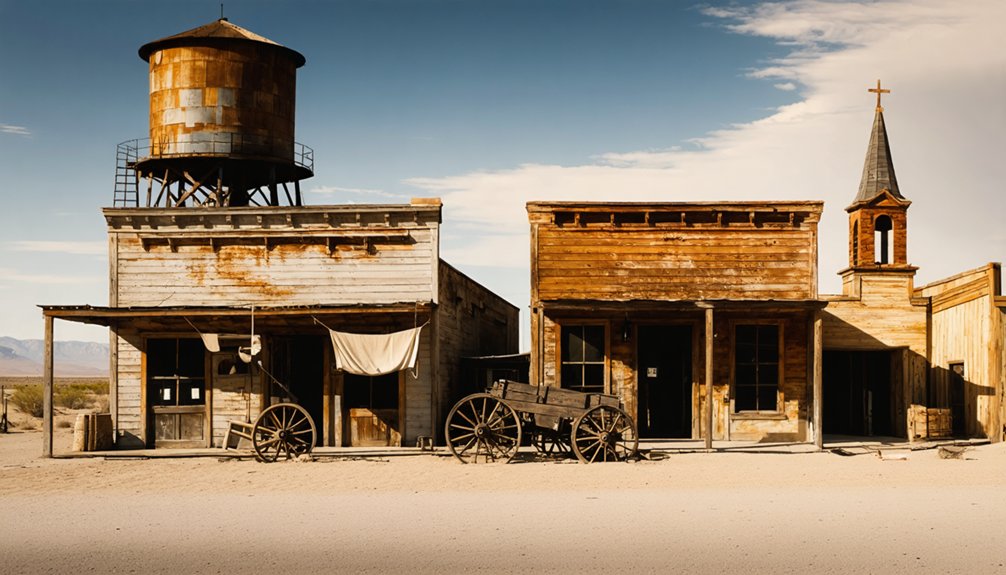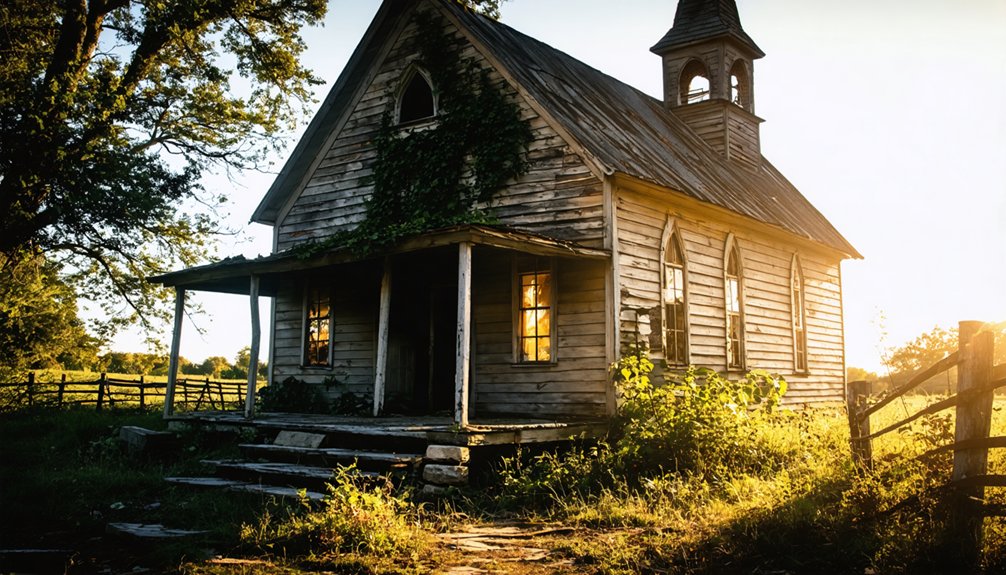Explore five haunting colonial ghost towns: Namibia’s diamond-rich Kolmanskop with its sand-filled rooms; Elizabeth Bay‘s stark reminder of diamond exploitation; Chinguetti‘s ancient manuscripts preserved amid encroaching desert; St. Elmo’s remarkably intact mining structures in Colorado’s mountains; and Custer’s boom-and-bust gold rush settlements. Each abandoned site offers a window into resource extraction’s transient nature and colonial ambitions. The stories behind their empty buildings reveal complex narratives of wealth, power, and decline.
Key Takeaways
- Kolmanskop, Namibia contains sand-filled German colonial buildings abandoned after the 1950s diamond boom collapsed.
- Elizabeth Bay’s ruins feature stark colonial hierarchies with European housing contrasting prison-like worker quarters.
- Chinguetti in Mauritania preserves ancient Islamic manuscripts despite desert encroachment threatening its 13th-century structures.
- St. Elmo, Colorado maintains 43 original structures from the 1880s mining boom that went bust by 1922.
- Custer’s gold rush towns in South Dakota and Idaho exemplify colonial resource exploitation and rapid abandonment after resource depletion.
The Sand-Swallowed Diamond Town of Kolmanskop, Namibia
Deep in the shifting sands of the Namib Desert lies Kolmanskop, a once-thriving diamond town whose rise and fall epitomizes the fleeting nature of colonial resource booms.
Founded after railway worker Zacharia Lewala’s 1908 discovery, this ghost town quickly grew to 1,300 residents, with German colonizers enjoying luxuries like imported Viennese sausages while Owambo laborers toiled under harsh conditions.
You’ll find eerily preserved remnants of a community that boasted southern Africa’s first X-ray machine—used primarily to scan workers suspected of swallowing diamonds.
When richer deposits were found in Oranjemund in 1928, Kolmanskop’s fate was sealed. By 1959, the desert reclaimed what colonial ambition had built.
Today, sand-filled rooms and crumbling infrastructure stand as haunting reminders of Kolmanskop’s colonial legacy—both its opulence and exploitation. The town was designed to resemble a German village settlement, complete with a concert hall, casino, and extensive railway connections to major cities. Photographers from around the world visit to capture the dramatic interplay of light and shadows within the decaying structures.
Elizabeth Bay’s Forgotten Mining Heritage
Just 70 miles south of Kolmanskop along Namibia’s forbidding Skeleton Coast lies Elizabeth Bay, a colonial diamond settlement whose haunting ruins tell an even darker tale of exploitation.
Established in the 1920s, this town exemplified the brutal reality of diamond extraction under colonial rule.
The site’s abandoned structures reveal a stark hierarchy of oppression:
- Comfortable German housing contrasted with locked, prison-like quarters for local workers
- A massive separation plant with rusting machinery standing as monuments to industrial greed
- An oceanside casino and entertainment hall that served only the European elite
- A sophisticated desalination plant that guaranteed operations continued despite the hostile environment
The town was known for its immense wealth of diamonds despite its relatively short operational period.
After producing 1.25 million carats, Elizabeth Bay was abandoned by 1948, leaving behind physical evidence of colonial exploitation that the desert slowly reclaims.
Like other mining settlements in the area, Elizabeth Bay miners had to endure extreme weather conditions while searching for diamonds in the harsh Namibian desert.
Chinguetti: Desert Library Among Ancient Ruins
While Namibia’s abandoned colonial settlements bear witness to industrial exploitation, another type of ghost town tells a starkly different tale of cultural preservation against environmental odds.
In Mauritania’s Chinguetti, you’ll find extraordinary libraries housing ancient manuscripts that have survived centuries despite the Sahara’s relentless advance.
Founded in 777 CE as a pilgrimage center, this seventh holiest city in Islam once thrived with 20,000 residents. Today, fewer than 1,000 remain as sand engulfs the UNESCO site.
Five family-owned libraries preserve thousands of Islamic texts on religion, astronomy, and medicine—a remarkable cultural heritage deteriorating under harsh desert conditions. During its peak, the city could accommodate up to 30,000 camels simultaneously due to its importance as a major trading hub. The city was once a thriving metropolis with a population reaching 200,000 at its height.
The town’s mud-brick architecture and 16th-century mosque stand as defiant sentinels against time, while custodians refuse to relocate their precious collections despite the desert’s 30-mile yearly encroachment.
St. Elmo: Preserved Splendor of America’s Mining Frontier
High atop Colorado’s rugged Collegiate Peaks, St. Elmo stands as one of America’s best-preserved ghost towns, where you’ll find the frozen remnants of an 1880s mining boom.
The town’s distinctive mining architecture—with steep metal roofs against fir-studded mountains—offers a pristine glimpse into frontier capitalism’s fleeting nature. The town was originally named Forest City before changing to St. Elmo after a popular 19th-century novel.
St. Elmo’s story follows the classic boom-to-bust narrative:
Like so many frontier dreams, St. Elmo’s tale of explosive growth and rapid abandonment epitomizes the American West’s ephemeral gold rush optimism.
- Founded in 1880, it swelled to 2,000 residents amid gold and silver fever
- Boasted five hotels, numerous saloons, and 150+ mine claims during its heyday
- Declined after ore depletion, losing its railroad lifeline by 1922
- Preserved largely by the Stark family, whose daughter Annabelle reportedly haunts the town
Many visitors report ghostly encounters while exploring the 43 remaining structures, where frontier dreams remain suspended in time. The Mary Murphy mine was a major contributor to the town’s wealth during its prosperous years.
Custer’s Gold Rush Legacy: A Frozen Moment in Time
The rocky landscapes of the American West harbor another remarkable frozen-in-time narrative beyond Colorado’s mining camps.
In 1874, Lieutenant Colonel George Armstrong Custer’s expedition to the Black Hills uncovered gold at French Creek, triggering dramatic gold rush dynamics that would shape American history.
You’ll find the first settlement, Custer, South Dakota, rose meteorically to 10,000 residents by 1876, only to collapse when richer deposits lured miners northward to Deadwood.
Meanwhile, its namesake in Idaho followed a parallel boom-bust cycle, thriving until 1904 before abandonment claimed it by 1910.
Both towns represent the transient nature of resource economies and devastating indigenous conflicts, as miners violated the Fort Laramie Treaty of 1868 with the Sioux.
These preserved ghost towns now serve as stark reminders of America’s complex westward expansion.
The discovery at Deadwood Creek eventually led to the establishment of the Homestake Mine, which would produce over 40 million ounces of gold and operate for 125 years until its closure in 2001.
Unlike many other gold rush settlements, Custer avoided complete abandonment thanks to the development of industrial mineral mining that sustained its economy when gold yields proved disappointing.
Frequently Asked Questions
How Are Ghost Towns Officially Designated and Protected?
You’ll find ghost towns designated through formal processes meeting designation criteria of historical significance and physical remnants, then protected via preservation efforts that include legal protections, signage, and documentation of remaining structures.
What Happened to Residents When These Towns Were Abandoned?
You’d witness a catastrophic residents’ migration as economic collapse forced families to seek livelihoods elsewhere. Historical impacts included community fragmentation, property abandonment, and cultural erasure when industries failed or disasters struck.
Are There Indigenous Perspectives on These Colonial Ghost Towns?
Yes. You’ll find indigenous narratives reframe these sites beyond abandonment, highlighting their continued cultural significance as spaces of contested memory, ancestral connection, and ongoing spiritual presence rather than empty colonial relics.
How Do Archaeologists Date Artifacts Found at These Sites?
You’ll find archaeologists using both relative techniques like stratigraphy and absolute methods like radiocarbon dating, while conducting detailed artifact analysis of ceramics, glass bottles, and architectural elements to establish precise chronologies.
Can Modern Technology Reveal Previously Unknown Features in These Towns?
Like an eagle with X-ray vision, you’ll find that drone surveying and ground penetrating radar reveal invisible town features—buried foundations, forgotten cemeteries, and hidden infrastructure networks completely obscured by centuries of natural reclamation.
References
- https://www.youtube.com/watch?v=tyXDXQSsuwA
- https://en.wikipedia.org/wiki/Wikipedia:WikiProject_Ghost_towns
- https://en.wikipedia.org/wiki/List_of_ghost_towns_by_country
- https://dot.ca.gov/-/media/dot-media/programs/environmental-analysis/documents/ser/townsites-a11y.pdf
- https://nicenews.com/culture/ghost-towns-across-america/
- https://en.wikipedia.org/wiki/Ghost_town
- https://www.geotab.com/ghost-towns/
- https://en.wikipedia.org/wiki/Wikipedia:WikiProject_Ghost_towns/Assessment
- https://www.loveexploring.com/gallerylist/188219/the-us-state-with-the-most-ghost-towns-revealed
- https://cdn.bookey.app/files/pdf/book/en/ghost-town-treasures.pdf



